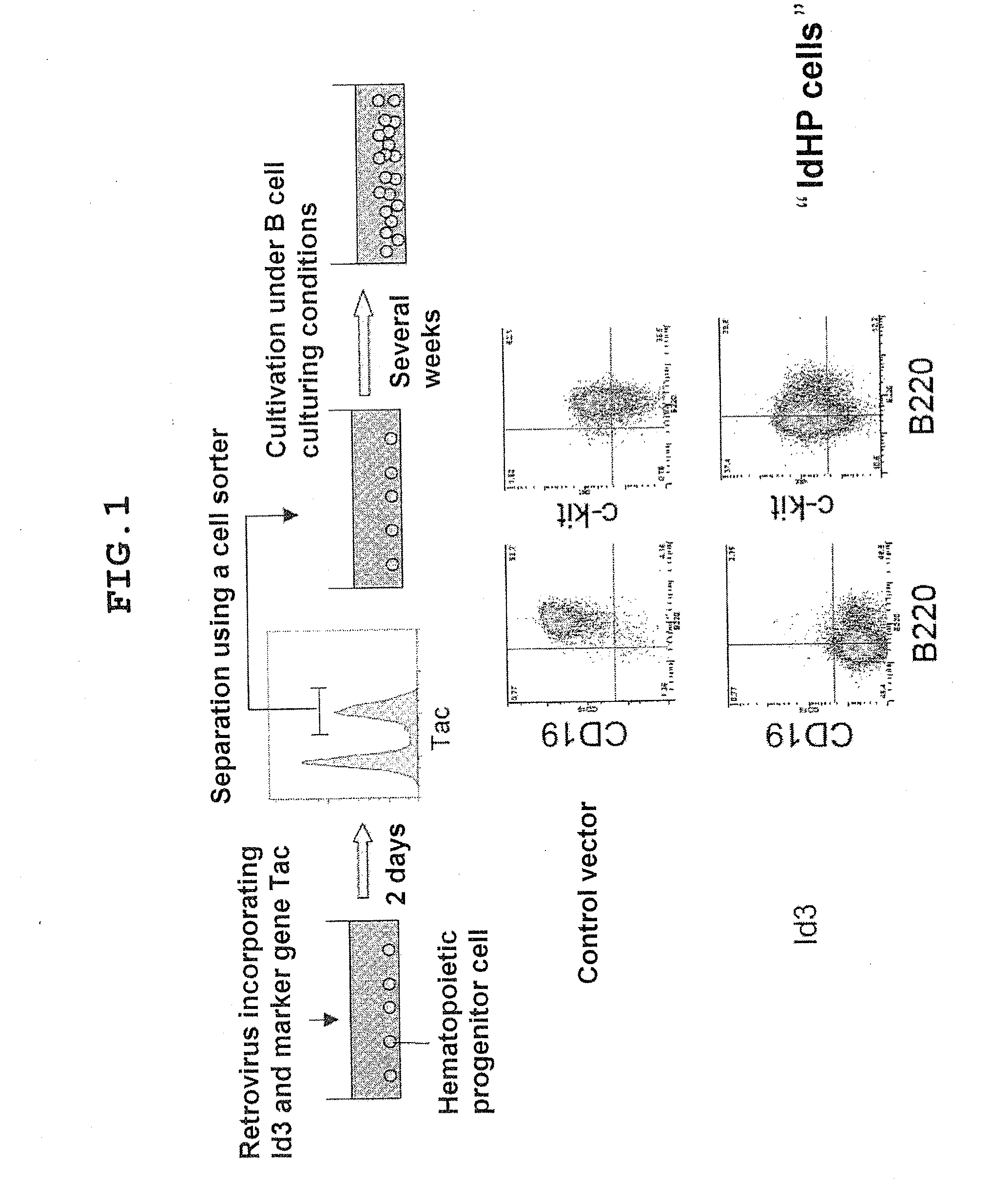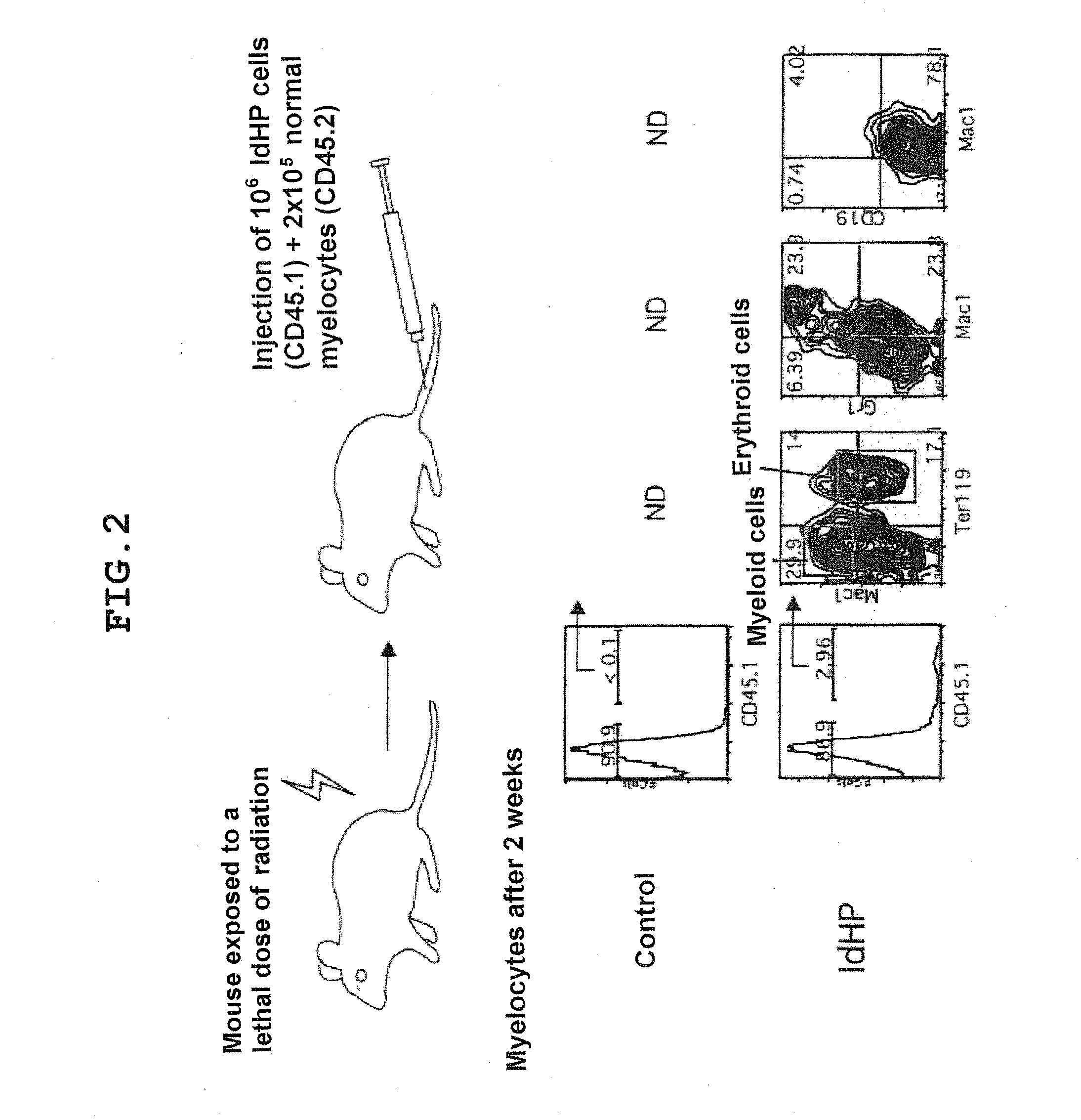Method for producing cells having characteristic of hematopoietic stem cells/progenitor cells
a technology of hematopoietic stem cells and progenitor cells, which is applied in the field of producing cells, can solve the problems of difficult to secure a donor, limited application to adults, and unavoidable burden on the donor, and achieves the effect of widening the scope of transplantation and reducing the burden on the donor of marrow fluid
- Summary
- Abstract
- Description
- Claims
- Application Information
AI Technical Summary
Benefits of technology
Problems solved by technology
Method used
Image
Examples
example 1
Preparation of Mouse Hematopoietic Stem / Progenitor Cells by Transfer of the Id3 Gene
[0111]FIG. 1 shows procedures for preparing hematopoietic stem / progenitor cells by transfer of the Id3 gene.
(1) Culturing Conditions for B Progenitor Cells
[0112]B progenitor cells were cultured using a medium containing 10% FCS, 200 U / ml penicillin, 200 ng / ml streptomycin, and 4 mM L-glutamine with the addition of IL7 (10 ng / ml), SCF (10 ng / ml), and FLT3 ligand (10 ng / ml).
(2) Isolation of Hematopoietic Stem / Progenitor Cells from Fetal Mouse Liver
[0113]Fetal mouse livers were stained with a mixture of antibodies against differentiation antigens that are specific for various series of blood cells (Lineage markers; Lin). Lin-negative cells were separated using a cell sorter.
(3) Transfer of the Id3 Gene
[0114]104 Lin-negative cells separated from a population of fetal liver cells were seeded onto the stroma cell TSt-4 in monolayer culture in a 24-well flat-bottomed plate. A retrovirus incorporating Id3 an...
example 2
In Vitro Proliferation Potential / Differentiation Potential Analysis of IdHP Cells
(1) In Vitro Proliferation Potential of IdHP Cells
[0116]If IdHP cells continue to be cultured under the conditions used for initial induction, they continue to proliferate for several months while in a homogeneous state without changing its morphology and surface antigen type. The proliferation rate was at the pace of about twice in 3 days. If it is assumed that cultivation was continued without discarding cells at the time of passage, the cells would have been multiplied more than one million folds during 2 months.
(2) In Vitro Differentiation Potential Analysis of IdHP Cells
[0117]The differentiation potential of IdHP cells multiplied by being cultured for about 1 month was analyzed using an in vitro differentiation induction system. When myeloid series colony production capability was examined by colony assay, about 30 myeloid series colonies were noted in a plate having 104 IdHP cells seeded thereto. ...
example 3
Hematopoietic Reconstruction Capability of IdHP Cells
[0118]To demonstrate the possession of the potential as hematopoietic stem cells, it is necessary to demonstrate the possession of the capability of continuing to produce cells of the primary series in vivo for a long period. In case of mice, the determination is made on the basis of whether or not a plurality of series of cells are detectable in peripheral blood for 8 weeks or more after transplantation to mice exposed to a lethal dose of radiation. Hence, 106 IdHP cells were transferred to each mouse exposed to a lethal dose of radiation. In this experiment, 2×105 normal marrow cells, as competitor cells, were transferred at the same time. IdHP cells and normal marrow cells are distinguishable using the surface antigen markers Ly5.1 (IdHP cells) and Ly5.2 (normal marrow cells). 2 weeks later, in the mice receiving the same number of control cells (cells infected with an Id3-free viral vector), no blood cells derived from the tra...
PUM
| Property | Measurement | Unit |
|---|---|---|
| temperature | aaaaa | aaaaa |
| temperature | aaaaa | aaaaa |
| mass | aaaaa | aaaaa |
Abstract
Description
Claims
Application Information
 Login to View More
Login to View More - R&D
- Intellectual Property
- Life Sciences
- Materials
- Tech Scout
- Unparalleled Data Quality
- Higher Quality Content
- 60% Fewer Hallucinations
Browse by: Latest US Patents, China's latest patents, Technical Efficacy Thesaurus, Application Domain, Technology Topic, Popular Technical Reports.
© 2025 PatSnap. All rights reserved.Legal|Privacy policy|Modern Slavery Act Transparency Statement|Sitemap|About US| Contact US: help@patsnap.com



